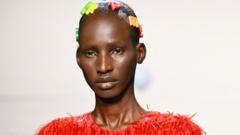The high-fashion landscape has seen a notable shift away from the body positivity movement, as models become increasingly thin and weight loss treatments grow in popularity. Industry figures reflect on this trend at Paris Fashion Week, revealing concerns over the narrow portrayal of beauty on runways.
Fashion Industry Reverts to Thin Models Amidst Body Positivity Decline

Fashion Industry Reverts to Thin Models Amidst Body Positivity Decline
As the fashion world leans back towards slim models, insiders speculate on the impact of weight loss drugs like Ozempic and the fading influence of the body positivity movement.
The fashion industry has long been critiqued for its emphasis on slenderness, but recent observations suggest a reinvigoration of this ethos, leaving the body positivity movement behind. Once a prominent voice championing diversity, body positivity has begun to dwindle since its peak in the 2010s, leading to questions about its lasting impact amid the resurgence of skinnier models.
The rise of this movement coincided with a shift in attitudes towards various body types, driven by the influence of social media. Pioneering moments, such as Ashley Graham gracing the cover of Sports Illustrated in 2015 and Rihanna's inclusive Savage x Fenty lingerie line, showcased the potential for representation. Yet, as we advance into 2024, experts indicate a striking decrease in diverse body representation on the runway.
Notably, data following the autumn and winter 2024 fashion shows reflects that a mere 0.8 percent of the 8,800 looks featured plus-size models, signaling a stark regression. As the buzz around weight loss medications like Ozempic and Wegovy gains traction, industry insiders suggest these influences further solidify traditional beauty standards. High-profile endorsements of such treatments from celebrities have sparked interest, creating a perception that thinner bodies are once again 'in.'
Models, whom we spoke to, share conflicting feelings about this transition. While some acknowledge increased job opportunities tied to the return of skinnier aesthetics, others express discomfort and anxiety over the pressure to conform to these standards. Chioma Nnadi, British Vogue's editorial director, voiced concerns about industry priorities, noting that the undertones of these trends do not contribute positively to the narrative of inclusivity.
The general sentiment at recent fashion events reveals a mixed landscape. While certain designers remain committed to inclusive casting, many others appear to revert back to historically favored archetypes, often sidelining fuller figures. This was evident at Paris Fashion Week, where attendees noted a scarcity of plus-sized models, with many brands using token representation merely to project an appearance of diversity.
As advocates question the sincerity of this inclusion, they highlight that, although the trend may seem cyclical, the current focus undermines the advancements made over past years towards broader representation. They emphasize the importance of consumer demand in propelling the change, suggesting that evolving purchasing behaviors could render a resurgence of body positivity.
The ongoing debate reflects larger societal negotiations over beauty, body image, and inclusivity, hinting that while the pendulum may swing back once more, the road towards equity in the fashion industry remains a work in progress.





















